The Cammen Lab welcomes their newest member, Alayna Hawkins, who begins an MS in Marine Biology program this summer. A recent graduate of St. Francis College in Pennsylvania, with an interest in marine mammal science and genetics, Alayna joins the lab to conduct research on gray and harbor seal immunogenetics. She hopes to help elucidate why gray seals appear more resistant than harbor seals to several viral diseases through an exploration of the genetic diversity of their immune systems.
The recent recovery of gray and harbor seals in the Northwest Atlantic, following historical exploitation and subsequent protection, provides a natural “experiment” in which to evaluate the impact of changes in population size and distribution on genetic diversity. It is a rare opportunity to test evolutionary theories, for example that genetic bottlenecks will reduce diversity (in extreme cases, leading to inbred populations), in a natural population. With a genomic approach, called RAD sequencing, we evaluated how diversity has changed over time and space in multiple cohorts of gray and harbor seals sampled over the past half-century. Our findings clearly show that signatures of historical bottleneck remain in the genomes of the species today, but also find high contemporary diversity, suggesting the species are not inbred. Interestingly, we find higher diversity in gray seals than harbor seals, which may have important implications for species fitness, a point we’d like to continue to investigate moving forward.
Co-authors on this paper include collaborators from the Duke University Marine Lab, NOAA NEFSC, Canada DFO, Tufts University, and St. Mary’s University. If you’re interested in other research we’ve done on this topic, check out our comparison of contemporary and archaeological seals from this region.
A full, freely available copy of our new open-source paper can be found here, or feel free to contact me directly for more information.
Cammen KM, Bowen WD, Hammill MO, Puryear WB, Runstadler J, Wenzel FW, Wood SA, Frasier TR, Kinnison M (accepted) Genomic signatures of population bottleneck, recovery, and expansion in Northwest Atlantic pinnipeds. Ecology and Evolution.
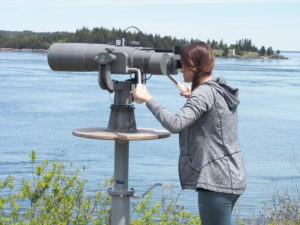
Liz Piotrowski scans for marine mammals in Western Passage using BigEyes.
This summer, undergraduate research assistants, Emma Newcomb and Liz Piotrowski, are leading a shore-based marine mammal visual monitoring program in Western Passage, a promising site for future tidal energy power. Once a week, they travel to Eastport, ME to conduct a 4-hour visual observation period, which later this summer will be supplemented by passive acoustic monitoring for marine mammal vocalizations (led by Chris Tremblay in Gayle Zydlewski’s lab). In their first month of observations, Emma and Liz have observed harbor porpoise, harbor seal, and minke whale.
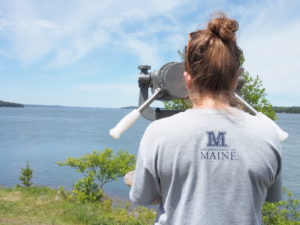
Emma Newcomb looks out over Western Passage in search of marine mammals.
This research is conducted in collaboration with Ocean Renewal Power Company. Emma’s summer internship, which also includes a historical analysis of marine mammal stranding rates in Maine, is funded by the SEA Fellows program.
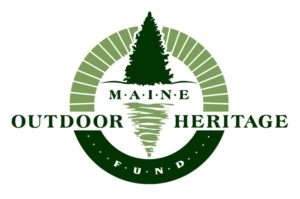 Our proposal entitled, Assessing predator risk to diadromous fish conservation in the Penobscot River Estuary, has received funding from the Maine Outdoor Heritage Fund. With this funding, we are excited to develop new collaborations with Justin Stevens and Christine Lipsky, of the NOAA Northeast Fisheries Science Center’s Atlantic Salmon Ecosystems Research Team, and Mitch Simpson at Maine Department of Marine Resources’ Division of Sea-Run Fisheries. The funding will support an analysis of existing and ongoing datasets on marine mammal abundance on the Penobscot River, which have been collected for the past five years during NOAA’s monthly or bimonthly surveys of the river. Combined with their data on fish abundance from hydracoustic and trawl surveys, and DMR’s data on observed injuries on salmon at the Penobscot River dams, we hope to better understand the potential impact of seal populations on local salmon and sturgeon.
Our proposal entitled, Assessing predator risk to diadromous fish conservation in the Penobscot River Estuary, has received funding from the Maine Outdoor Heritage Fund. With this funding, we are excited to develop new collaborations with Justin Stevens and Christine Lipsky, of the NOAA Northeast Fisheries Science Center’s Atlantic Salmon Ecosystems Research Team, and Mitch Simpson at Maine Department of Marine Resources’ Division of Sea-Run Fisheries. The funding will support an analysis of existing and ongoing datasets on marine mammal abundance on the Penobscot River, which have been collected for the past five years during NOAA’s monthly or bimonthly surveys of the river. Combined with their data on fish abundance from hydracoustic and trawl surveys, and DMR’s data on observed injuries on salmon at the Penobscot River dams, we hope to better understand the potential impact of seal populations on local salmon and sturgeon.
A secondary aim of this proposal is to begin to develop a seal photo-identification research program on the Penobscot River. This portion of the research will begin next summer, so stay tuned for some seal photos on an upcoming project website!
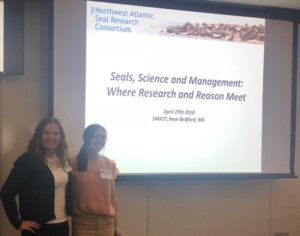
Sarah Vincze and Sarah Burton represented the Cammen Lab at the 2018 Northwest Atlantic Seal Research Consortium (NASRC) Meeting. Sarah Vincze was invited to give an oral presentation on our recently published paper, Genetic Diversity from Pre-bottleneck to Recovery in Sympatric Pinnipeds in the Northwest Atlantic.
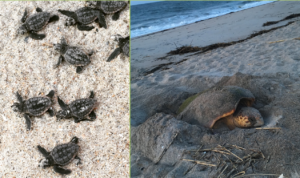
Congratulations to Faythe Goins, who publicly defended her undergraduate Honors thesis research this afternoon in front of friends, family, academic colleagues, and the entire UMaine women’s softball team! Faythe studied how environmental factors, such as temperature, cloud cover, and precipitation, have affected loggerhead sea turtle nesting on Edisto Island, SC over the past 8 years. In addition to her research, Faythe presented a reading list of books, texts, and musical pieces that have been important to her throughout her college career. For her excellent thesis and presentation, Faythe earned Highest Honors!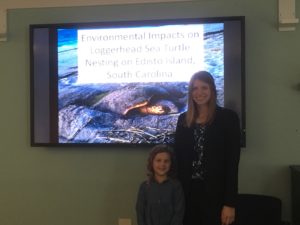 Faythe’s analysis relied on long-term data collected by volunteers for the SC Department of Natural Resources, a program which Faythe herself has participated over the past 4 summers. Faythe is excited to spend one more summer on sea turtle patrol in SC before heading to the University of Georgia Veterinary School this fall.
Faythe’s analysis relied on long-term data collected by volunteers for the SC Department of Natural Resources, a program which Faythe herself has participated over the past 4 summers. Faythe is excited to spend one more summer on sea turtle patrol in SC before heading to the University of Georgia Veterinary School this fall.
This week three undergraduate students in the Cammen lab presented their research at UMaine student research symposia. Please join us in congratulating the students for their excellent poster presentations!
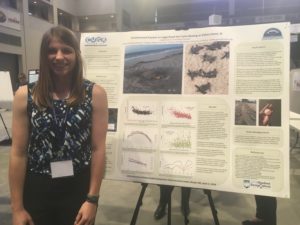 Faythe Goins presented her honors thesis research, Environmental Impacts on Loggerhead Sea Turtle Nesting on Edisto Island, SC, at the 2018 UMaine Student Symposium and won best poster presentation in Natural Sciences! She also presented her research at the School of Marine Sciences Capstone Symposium, and will publicly defend her thesis next week.
Faythe Goins presented her honors thesis research, Environmental Impacts on Loggerhead Sea Turtle Nesting on Edisto Island, SC, at the 2018 UMaine Student Symposium and won best poster presentation in Natural Sciences! She also presented her research at the School of Marine Sciences Capstone Symposium, and will publicly defend her thesis next week.
 Kai LaSpina presented preliminary results from her Capstone research, Investigating the relationship of mass stranding events and genetic relatedness in the Atlantic white-sided dolphin, Lagenorhynchus acutus, at the 2018 UMaine Student Symposium. Stay tuned for future results and presentations of Kai’s research!
Kai LaSpina presented preliminary results from her Capstone research, Investigating the relationship of mass stranding events and genetic relatedness in the Atlantic white-sided dolphin, Lagenorhynchus acutus, at the 2018 UMaine Student Symposium. Stay tuned for future results and presentations of Kai’s research!
Sarah Vincze presented her senior Capstone research, An analysis of bottlenose dolphin (Tursiops truncatus) unusual mortality events along Florida’s Gulf of Mexico coastline in association with Karenia brevis blooms, at the School of Marine Sciences Capstone symposium.
With the start of a new year and a new semester, it’s time to welcome new and returning members of the Cammen Lab. This semester, Emma Newcomb, Sarah Burton, and Holland Haverkamp have returned to the lab to continue their research on marine mammal stranding rates in Maine. Kai LaSpina is continuing her research on genetic relatedness of mass stranded Atlantic white-sided dolphins. Sarah Vincze continues her Capstone literature review on the effects of HABs on bottlenose dolphins and is back in the lab, after a semester at the Darling Marine Center, to collaborate on various marine mammal genetics projects. Faythe Goins is preparing to defend her Honors thesis on loggerhead sea turtle nesting trends in South Carolina later this spring. This semester, we also welcome two new members: Emma Spies, a freshman UMaine Top Scholar, who will be initiating a project on immunogenetic diversity in gray and harbor seals, and Liz Piotrowski, who is starting her Capstone research on Atlantic white-sided dolphin sightings in the Gulf of Maine. It’s exciting to have a great group of students involved in our research and we all look forward to a productive semester! You can learn more about these students and opportunities to join the Cammen Lab here.
As a final project, this year’s INT308 (Marine Mammal Ecology and Conservation) undergraduate students produced the inaugural Marine Mammals in the News online publication. From whales to manatees, from the Arctic to Mexico, from conservation to physiology, and much more – check out the stories they wrote, highlighting marine mammal science that has been published within the last year.
We are pleased to announce the recent publication of our study of genetic diversity among archaeological and contemporary gray and harbor seals from the Northwest Atlantic. In our paper, we describe finding greater genetic diversity in both seal populations prior to the bounties of the early and mid-1900s. We further present evidence that is consistent with the potential loss of a historical Maine subpopulation of gray seals. These findings are significant to the discussion of how to manage gray and harbor seals today as their populations recover along parts of Maine, Massachusetts, and the Canadian Maritimes.
The co-authors on this paper include undergraduate Sarah Vincze, graduate student Sky Heller, and professor Mike Kinnison from the University of Maine, as well as collaborators from NOAA NEFSC, Canada DFO, Tufts University, and St. Mary’s University. The project was enhanced by the diverse perspectives of geneticists, ecologists, field biologists, and archaeologists.
Our paper can be found here, or feel free to contact me directly for more information.
Cammen KM, Vincze S, Heller AS, McLeod BA, Wood SA, Bowen WD, Hammill MO, Puryear WB, Runstadler J, Wenzel FW, Kinnison M, Frasier TR (2018) Genetic diversity from bottleneck to recovery in two sympatric pinniped species in the Northwest Atlantic. Conservation Genetics. 19: 555-569.

